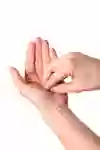Basic hygiene routines
Hand hygiene
Contact transmission by hands is the most common mode of transmission in health and social care. Hand disinfection and sometimes handwashing is performed to remove infectious agents and thereby break the mode of transmission [2,3].
Hand disinfection
Disinfect hands using an alcohol-based hand disinfectant or other product with equivalent effect (SOSF 2015:10). Use products procured by the employer, which must comply with SS-EN 1500:2013, SS-EN 13727:2012+A2:2015 and SS-EN 13624:2013 (yeast fungus) [4]. See information from supplier for information on shelf life.
- Disinfect hands
immediately before and after contact with a patient (SOSF 2015:10) [3] - after contact with a surface or object in the immediate environment of the patient [3]
- before a clean or aseptic task, for example before work where the level of cleanliness of products is to be maintained, catheterisation, wound care, injection administration, and handling of medicines and food [3]
- before [5] and after using gloves (AFS 2018:4)
- after tasks where hands have become contaminated or dirty [3]
- after handwashing (SOSF 2015:10) [2,5].
Hand disinfection steps
- Cup your hand and fill it with hand disinfectant, 2–4 mL depending on the size of your hands. The amount of disinfectant should be large enough to cover the entire skin surface.
- Rub the disinfectant all over your hands. Start with the palms, the back of the hands, the fingertips, around all the fingers and thumbs. Finish with the wrists. If necessary, disinfect the whole forearm.
- Continue rubbing as described in point 2 until the skin feels dry; takes about 20–30 seconds.
If you need to disinfect your whole forearms, increase the amount of hand disinfectant [3,5].
Further information is found on the page Related information.

Take 2–4 mL of hand disinfectant.
Handwashing
Wash your hands with liquid soap and water before hand disinfection
- if hands are visibly dirty or feel dirty
- if the patient has vomited or has diarrhoea
- if hands have become contaminated with body fluids (SOSF 2015:10) [3].
Handwashing steps
- Wet your hands with running water.
- Apply liquid soap to your hands.
- Rub the soap into your hands until it lathers.
- Make sure that the soap covers all surfaces of your hands. Start by rubbing the palms, the back of the hands, the fingertips, around all the fingers and thumbs. Finish with the wrists. If necessary, wash your forearms as well.
- Rinse off the soap with running water.
- Dry your hands with paper towels.
- Turn off the tap using a paper towel or your elbow [3].
- Disinfect your hands as described under the heading "Hand disinfection" above.
Liquid soap usually has a limited shelf life after the container has been opened. The bottle must be labelled with a symbol indicating how long the product can be used for after opening (EC 1223/2009). Label the bottle with the date it was opened.
Glove usage in health and social care
Gloves are for one-time use only and must be changed between each task and each patient. They are worn when in direct contact with body fluids or when there is a risk of exposure to body fluids such as saliva, blood, urine, faeces, vomit and other bodily secretions (SOSF 2015:10, AFS 2018:4). Gloves are also worn when performing activities that result in the hands becoming dirty and when in contact with disinfectants (AFS 2011:19).
Do not reuse or disinfect gloves. Gloves are used to prevent the hands from becoming heavily contaminated with microorganisms. When gloves are used, it is sufficient to disinfect the hands after the task has been completed [2].
Local instructions specify which gloves should be used in different situations and care activities.
Aprons and gowns
Infectious agents can spread between patients and staff via contaminated work clothing.
A disposable plastic apron or a gown must be worn when there is a risk of work clothing becoming contaminated through direct contact with a patient, body fluids, or other biological material, such as skin and skin scales (SOSFS 2015:10) [2].
Disposable plastic aprons must be discarded immediately after use and between each patient. If a reusable gown is used, it should only be worn in relation to one patient (SOSFS 2015:10). Change the reusable gown daily and when it is visibly soiled or damp. For wet tasks, use a disposable plastic apron [2].
Local instructions will specify whether aprons or gowns with more extensive coverage need to be used for specific infections or situations.
Visor/face shield or surgical face mask in combination with goggles
For tasks where there is a risk of body fluids splashing on the face, protective equipment such as a full-face visor/face shield must be used. Alternatively, goggles can be used in combination with a fluid-repellent surgical face mask (type IIR) (AFS 2018:4) [2].
Management of body fluid spillages
To reduce the risk of transmission of infections, spillages of body fluids must be decontaminated immediately with an alcohol-based surface disinfectant with surfactant or a disinfectant with equivalent effect [2]. Gloves must be worn when in contact with disinfectants (AFS 2011:19).






